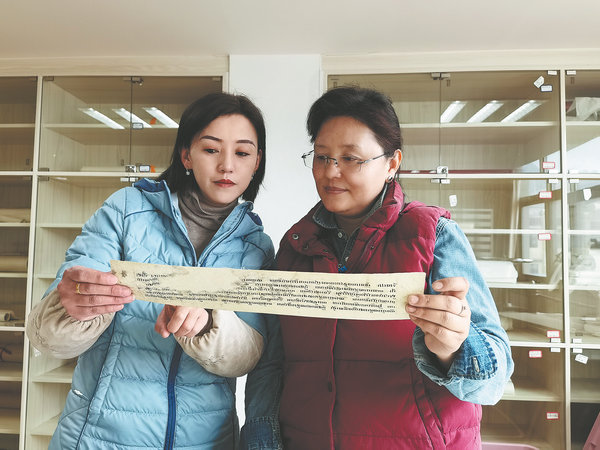
For Yangla and Tseyang, restorers of Tibetan ancient texts, working on a piece of ancient scripture is like nursing their own babies — the work requires extraordinary patience, attentiveness, affection and endurance.
While patching a gap on a page of ancient scripture, they have to frequently use blotting paper to absorb liquid oozing from the patch.
According to Yangla and Tseyang, they have to keep changing the blotting paper until it completely dries. "The frequency of changing blotting paper is much higher than changing diapers," they say, laughing in their workshop.
After getting involved in this work a decade ago, they have dedicated themselves to the restoration of ancient Tibetan documents.
They both work in the Tibetan Ancient Documents Restoration Center, which is affiliated with the Tibet Ancient Documents Preservation Center of the regional library of the Tibet autonomous region.
Since its establishment in 2015, the center has been restoring ancient documents from a number of monasteries in the region, and it has recently completed the restoration of Kagyur scriptures of the Bon religion from the Pula Monastery in Drachen county.
Regarded as a rare version of the ancient texts, the Kagyur scriptures from the Pula Monastery have been listed in the catalogue of National Rare Ancient Books, and it is the first time that Tibet has completed the restoration of such a document.

According to Yangla and Tseyang, the restoration, which took them more than 18 months, involved two volumes and 453 pages.
The amount of time required to restore a page can be anywhere between half a day and three days. The scriptures in the monastery were damaged by damp, parts of most pages were lost, and they had to prevent them from further deterioration.
"While repairing a damaged page, our goal is to make it look close to the original. Therefore, choosing the right paper and the right color are challenging," says Yangla.
To find the right material, they ordered paper from different Tibetan producers. The paper from the region's Nyemo county works better, they say.
"In order to ensure a match, we tell the producers to make the paper with a certain color, and it is very helpful," says Tseyang.